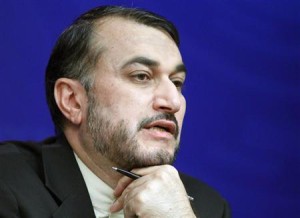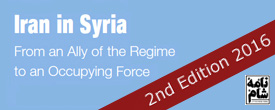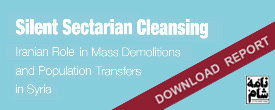 The Iranian deputy foreign minister for Arab and African affairs claims his government is not seeking to keep Syria’s dictator in power forever, implying he could potentially be replaced by another ally of Iran. Yet Amir Abdollahian insists that Bashar al-Assad still serves Iran’s purported strategic interests, so he is staying in spite of everything.
The Iranian deputy foreign minister for Arab and African affairs claims his government is not seeking to keep Syria’s dictator in power forever, implying he could potentially be replaced by another ally of Iran. Yet Amir Abdollahian insists that Bashar al-Assad still serves Iran’s purported strategic interests, so he is staying in spite of everything.
In an interview with Reuters on 2 April 2014, [1] the Deputy Foreign Minister said: “We are not seeking to have Bashar al-Assad remain president for life. But we do not subscribe to the idea of using extremist forces and terrorism to topple Assad and the Syrian government.” This is a classic scare-mongering argument that has been used by the Syrian regime for years: if al-Assad goes, you will get Islamist extremists and terrorists, so you better stick to his side. As if the only other alternative to al-Assad is, or has to be, extremists and terrorists.
Let’s remind Mr Abdollahian and those who may believe him that the Syrian ‘president’ and his ‘government’ are illegitimate in the first place. Bashar al-Assad was brought back from abroad after his father fell ill and his elder brother died and was appointed as president by the ruling inner circle after the constitution was hastily changed so as to lower the minimum age for presidency candidates from 40 to 34, which was his age at the time. His regime has only remained in power by force and through repression.
Let’s remind Mr Abdollahian that many of the extremist forces he is talking about were actually created or infiltrated by the Syrian and Iranian regimes and have been serving these regimes’ agenda rather than that of the Syrian revolution or opposition. [2] And in any case, shouldn’t these ‘extremist forces’ also include Hezbollah Lebanon and the Iraqi militias fighting in Syria, which are armed, financed and controlled by the Iranian regime?
Abdollahian insists that Iran’s “aid” to Syria is limited to “humanitarian goods such as food and medicine”. Yet recent media and intelligence reports reveal that the Iranian regime has in recent months increased its military support for al-Assad’s forces by sending more Sepah Qods and Basij commanders to train these forces and direct operations on the ground, gather information and so on. [3] Not to mention new Iranian weapons (e.g. Falaq and Burkan rockets) shipped to Syria, in addition to paying for most of the Russian arms provided to the regime forces. We also already know – from admissions and slips of the tongue by other Iranian officials – that the Iranian regime has been funding and training Syrian regime forces and the militias fighting alongside them since the early days of the revolution. [4] If funding, training, facilitating and directing armed forces does not constitute military intervention, then we don’t know what does.
Despite all the Iranian talk about “parallel tracks” and a “four-part plan for Syria”, the fundamental equation at the heart Iran’s (public) policy on Syria does not appear to have changed one inch: “We have a deep relation with Syria. It’s a strategic ally against Israel,” Abdollahian adds. The good old Israel excuse. As if Bashar al-Assad has been fighting Israel or has any intention or ability to ever do so. It is indeed interesting that the two main powers that insist on al-Assad staying in power are Iran and Israel. [5]
Abdollahian was speaking after talks in Kuwait with United Arab Emirate’s Minister of State for Foreign Affairs. The Iranian government seems to be trying to resolve “misunderstandings” with the Gulf countries – mainly Saudi Arabia – about Syria, Iraq and Bahrain. “We are hoping to have discussions in the next month, or at the earliest possible moment,” Abdollahian said.
What these regional players – whether it’s Iran, Turkey, Saudi Arabia or Qatar – seem to forget is that every single day in their political games is costing hundreds of lives and more and more destruction in Syria. Even if we believed the Iranian government does not want Bashar al-Assad to remain president for life, it seems they want him to stay in power until the rest of the Syrian population and infrastructure are irreversibly destroyed.
NOTES:
[1] Reuters, http://www.reuters.com/article/2014/04/02/us-iran-syria-idUSBREA311X220140402[2] See for example:
http://www.naameshaam.org/en/the-tale-of-three-islamist-leaders-who-were-released-from-prison-by-the-syrian-regime/
http://www.naameshaam.org/en/is-the-iranian-government-supporting-both-sides-of-the-war-in-syria/
[3] See for example:
http://ara.reuters.com/article/topNews/idARACAEA1K08I20140221?pageNumber=1&virtualBrandChannel=0
[4] See for example:
http://www.naameshaam.org/en/iranian-mp-revealing-details-of-irans-military-support-of-syrian-regime-against-national-interests/
http://www.naameshaam.org/en/iranian-general-admits-advising-syrian-regime-on-establishing-shabbiha-paramilitary-force/
[5] See for example:
http://www.haaretz.com/news/diplomacy-defense/israeli-official-assad-preferable-to-extremist-rebels-the-times-of-london-reports-1.524605
http://www.foreignaffairs.com/articles/139373/efraim-halevy/israels-man-in-damascus?cid=soc-facebook-in-snapshots-israels_man_in_damascus-051015
 English
English  فارسی
فارسی  العربية
العربية 




 On Twitter
On Twitter